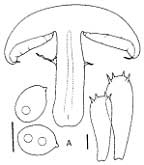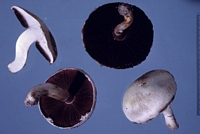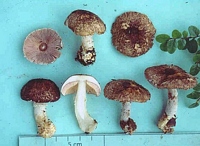Agaricus arvensis
|
 | The Horse mushroom. Large mushrooms, cap up to 20 cm or more, an introduced species, always on grass in parks, etc. The whitish cap sometimes stains slightly yellowish with age, but the flesh inside the stalk never stains yellow. Edible and good. |
|

|

|
Agaricus campestris
|
 | The field mushroom. An introduced fungus, often seen in large numbers in heavily fertilised grassy areas in cities, as well as on farms. Edible and good. Agaricus cupreobrunneus is found in similar places, but has a brown, slightly hairy cap. |
|

|

|
Agaricus lanatoniger
|
 | One of the indigenous species. Has been collected in several different kinds of forest from Nelson northwards. |
|

|

|